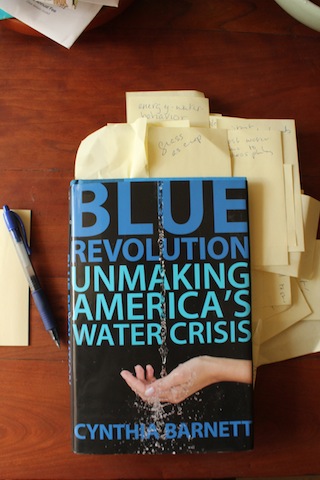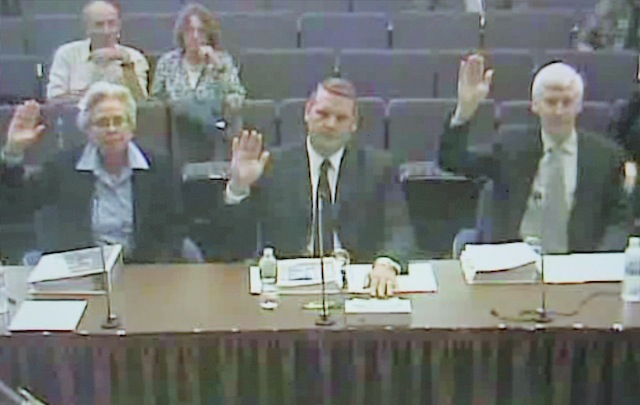Image of the day: River of No Return
Posted on | October 18, 2011 | No Comments
 “The Middle Fork of the Salmon is not so much a river as an exuberant expression of water at play,” writes Joel K. Bourne, Jr. “It tumbles and turns and trips over itself for a hundred miles through the largest unbroken wilderness in the lower 48, the 2.3-million-acre Frank Church–River of No Return Wilderness, named for the pristine Salmon River gorge and the Idaho senator who made sure most of its vast watershed would stay that way. No dams temper its flow. No roads line its banks. It dances down its canyon much as it has since the glaciers receded 10,000 years ago—in spring as a raging, tree-felling torrent, in late summer as a spare, crystalline rivulet.
“The Middle Fork of the Salmon is not so much a river as an exuberant expression of water at play,” writes Joel K. Bourne, Jr. “It tumbles and turns and trips over itself for a hundred miles through the largest unbroken wilderness in the lower 48, the 2.3-million-acre Frank Church–River of No Return Wilderness, named for the pristine Salmon River gorge and the Idaho senator who made sure most of its vast watershed would stay that way. No dams temper its flow. No roads line its banks. It dances down its canyon much as it has since the glaciers receded 10,000 years ago—in spring as a raging, tree-felling torrent, in late summer as a spare, crystalline rivulet.
“Today it is one of the ultimate white-water experiences in the United States, drawing thousands of visitors each year. But 60 years ago its future—and that of hundreds of other rivers across the country—looked very different. For much of the 20th century, the federal government seemed determined to dam virtually all the major rivers in the country, harnessing their power for electricity, irrigation, navigation, water supply, and flood control. The dam binge was particularly acute in the arid West, where even the Grand Canyon was slated for flooding. The Army Corps of Engineers evaluated five prospective dam sites on the Middle Fork alone. The river would have morphed into a chain of man-made lakes if two brothers hadn’t helped stem the tide of concrete.”
Click here to keep reading Bourne’s sublime piece about America’s wild and scenic rivers in the November issue of National Geographic, and here to see the accompanying photo gallery by Michael Melford featuring Idaho’s Salmon (above), Alaska’s Tinayguk, California’s Merced, Oregon’s Owyhee and Upper Rogue, South Carolina’s Chattoga, Wyoming’s Snake, Florida’s Loxahatchee rivers and more.
Tags: chance of rain > Joel K. Bourne > National Geographic > wild and scenic rivers
The Dry Garden: In search of a ‘water ethic’ for America
Posted on | October 14, 2011 | No Comments
 Most high-level arguments about how to conserve water in the garden take place without involving home gardeners. Rather, as water managers weigh what an imaginary average consumer would and would not do by way of conservation, we real-life consumers are alternately offered carrots in the form of ephemeral rebate programs and sticks in the form of emergency sprinkler ordinances.
Most high-level arguments about how to conserve water in the garden take place without involving home gardeners. Rather, as water managers weigh what an imaginary average consumer would and would not do by way of conservation, we real-life consumers are alternately offered carrots in the form of ephemeral rebate programs and sticks in the form of emergency sprinkler ordinances.
The new book, “Blue Revolution: Unmaking America’s Water Crisis,” knocks this tired see-saw off its axis. Author Cynthia Barnett argues that no conservation program will truly succeed unless embraced by the public as part of a universally adopted “water ethic.” After research took her across the US, to the Netherlands, Singapore and Australia, Barnett concluded that the only way that a water ethic can be reintroduced to places that have lost it is if a primal sense of the importance and beauty of water is restored.
It’s unorthodox to review this book in a garden column, but it was equally unorthodox for Barnett to open “Blue Revolution” in a garden, standing on lawn, looking at a pool and artificial waterfall. Embarrassingly for a reviewer based in California, the phony Eden she captured was in Sacramento. While the capital of California is celebrated as green for its encouragement of public transport and strides in LEED-certified construction, its outdoor water use, Barnett observes, makes it “one of the most water-wasting places on the planet.”
Click here to keep reading this review of “Blue Revolution” in the Los Angeles Times.
The Dry Garden: Capturing rain
Posted on | October 7, 2011 | No Comments

With the first rain of the season comes a question: How best to capture it for the garden? There is no single answer. Each property has dramatically different opportunities and challenges. Get it right and rainy season becomes a time of unrivaled beauty and pleasure. Get it wrong and you can ruin your house, or your neighbor’s.
This week “The Dry Garden” in the Los Angeles Times is soaked. Click here to keep reading about harvesting rain.
Tags: chance of rain > Emily Green > Los Angeles Times > rainwater harvesting
The Dry Garden: Ask Persephone
Posted on | September 30, 2011 | No Comments

Plant a pomegranate and the hole you dig drives straight through time — Persephone deep, founding fathers deep. Pomegranates are in Greek and Persian mythology, the Bible, the Koran, on the seal of the British Royal College of Physicians. Scholarly gardening articles cite pomegranates as having figured in gardens in the colonial Carolinas. Spanish settlers brought them to California. Search the botanical name Punica granatum in technical journals and you find the chemists at L’Oreal are onto them: Pomegranates are named in a new patent for shampoo. Health publications carry studies on the anti-oxidant properties. Martha Stewarts everywhere recommend dried pomegranates for Christmas wreaths.
But gardeners can turn up a lot of trivia without learning one key fact: how to tell when they are ripe. (Hint: the one above isn’t). Click here to keep reading about growing pomegranates to crimson readiness in this week’s Dry Garden column in the LA Times.
Opening day notes
Posted on | September 26, 2011 | 5 Comments

From left to right: Las Vegas water authority witnesses Kay Brothers, John Entsminger and Richard Holmes were sworn in on Monday, September 26th at the Carson City hearings being held by the State Engineer of Nevada to determine whether and in what quantity to permit groundwater pumping for a Las Vegas pipeline.
Pat Mulroy seemed haggard and uncharacteristically subdued as hearings commenced today in Carson City over whether to allow Las Vegas to pump groundwater from four rural valleys to support more casinos and houses in Southern Nevada. Yet, as she took more than half a day’s questioning, the performance today by Southern Nevada Water Authority’s controversial general manager built into one of her best. She all but annihilated suggestions by opponents that increased conservation, water trades from California or desalination were magic bullets that would obviate the need for rural groundwater to keep Las Vegas in business. Anyone who doubts her mastery of Colorado River politics should seek out copies of today’s testimony.
As good a speaker as Mulroy can be, and today she was great, she was also aided and abetted by the rules of engagement. Carson City civility and debatable definitions of “beneficial use” of water prevented the asking of the most obvious question: Who in their right mind would support destroying some of the most beautiful valleys in the west — most of them federal public land — to support unchecked expansion of what amounts to an urban hybrid of Disneyland and Gomorrah?
The other elephant in the hearing room, or in this case, the dolphinarium in the Mojave, remains the absurdity of pursuing growth in a metropolis located in what is already a desert and is expected to become even hotter and drier with climate change.
Gains from Mulroy’s performance were drastically undermined late in the day when a SNWA attorney tried to certify Kay Brothers, Mulroy’s former deputy, as “an expert for hydrological modeling for water planning purposes.” Three years ago, it was revealed that Brothers and the attorney were among an inner circle of pipeline architects who attempted to suppress models by real hydrologists showing the devastating impact that the proposed pipeline would have on the target valleys. The hearings officer declined to certify Ms Brothers as an expert on modeling.
« go back — keep looking »


